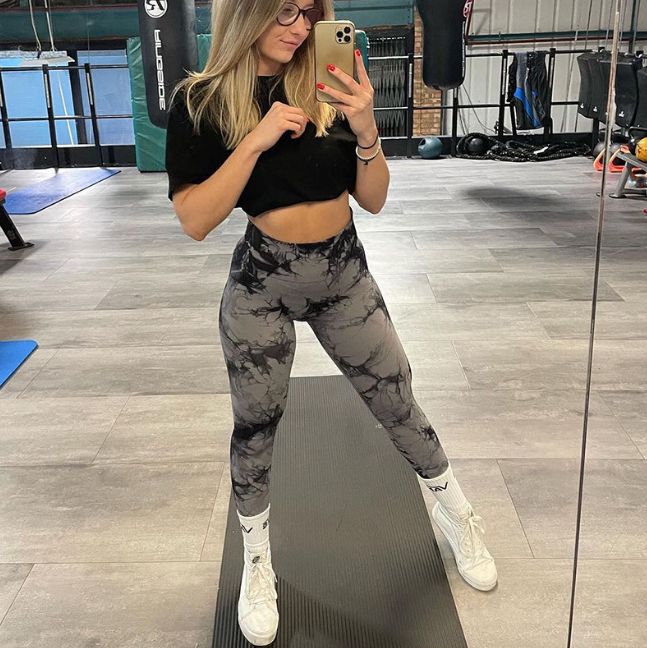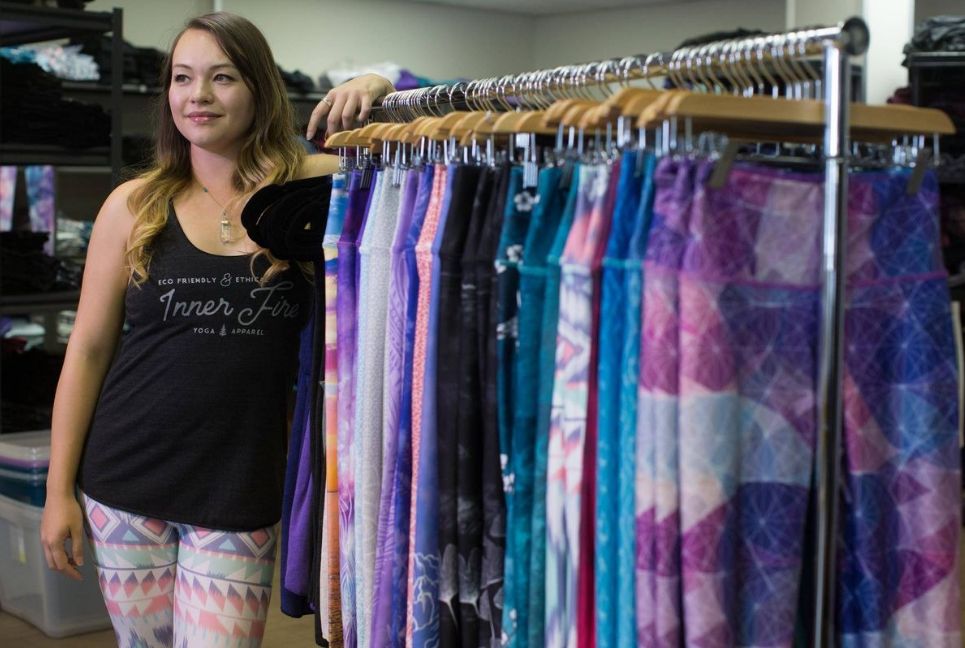How to Find the Perfect Yoga Apparel Supplier?
 2024-01-15
2024-01-15

 Sansansun
Sansansun
Introduction
In the yoga, attire plays a pivotal role. Identifying an exemplary yoga apparel supplier becomes crucial. This blog's essence: a guide, a compass in this quest. It weaves through the myriad of suppliers' landscapes, seeking quality and style.
Expect insights, tangible advice, and a clear path towards that ideal eco-friendly yoga apparel supplier partnership. A journey begins, not just in selection, but in elevating your yoga experience.
What’s Your Business's Specific Needs for Yoga Apparel?

Selecting an eco-friendly yoga apparel supplier demands precision, akin to executing a perfect Vrksasana. Fabric type, a pivotal factor, determines comfort and flexibility. Consider moisture-wicking materials, ensuring users remain dry during intense sessions. Size range diversity, from XS to XL, caters to all body types. Stitch quality, often overlooked, is crucial for durability; seek triple-stitched seams.
Style variety, from leggings to tank tops, appeals to diverse preferences. Colorfastness, ensuring hues remain vibrant, is essential. Supplier location impacts delivery times; closer suppliers offer swifter distribution. Eco-friendliness, a growing concern, should be considered.
Ethical manufacturing practices, reflecting social responsibility, must not be neglected. Inventory management capabilities, ensuring consistent supply, are key. Min. order quantities (MOQs) dictate stock levels. Payment terms, affecting cash flow, require negotiation. Return policies, for defective items, must be clear. Tech high-support, in case of queries, should be accessible.
Shipping options, from standard to expedited, vary in cost. User feedback, reflecting real-world experiences, guides better choices. Warranty periods, covering defects, differ among suppliers. Wholesale discounts, for bulk purchases, reduce costs. Yoga apparel, an amalgamation of style and function, demands meticulous supplier selection.
How Do You Assess a Supplier's Reputation and Reliability?

·Market Presence
In the yoga apparel, brand longevity signals stability. A decade's existence follows a testament to consistency. Market share analysis reveals brand power. Dominance in the yoga sphere echoes quality. Seek out suppliers with high visibility in trade shows. Presence at renowned fitness expos speaks volumes.
·Client Feedback
Client testimonials serve as a compass. Seek out yoga studios' opinions. In-depth reviews from instructors offer insight. Satisfaction rates, a reliable gauge. Prioritize suppliers with minimal complaints. Complaint resolution efficiency is a critical metric. Positive feedback from large-scale buyers is green signal.
·Quality Certifications
ISO 9001: a beacon of quality. Seek suppliers with such credentials. Yoga apparel requires stringent safety standards. Certifications like OEKO-TEX® matter. Compliance with ASTM standards is crucial for durability. Quality badges on websites are key indicators. Regular audits of suppliers reinforce trust.
·Delivery Record
On-time delivery: a non-negotiable criterion. Scrutinize past order fulfillment records. Short lead times, a competitive advantage. Suppliers with <2% late delivery rates excel. Track records of meeting tight deadlines are crucial. JIT (Just In Time) capabilities, a significant plus. Assess delivery consistency over multiple years.
·Eco Credentials
Sustainability is the new norm in yoga wear. Certifications like GOTS (Global Organic Textile Standard) matter. Suppliers embracing carbon-neutral practices excel. Usage of recycled materials are plus.
Water conservation efforts in manufacturing count. Eco-friendly packaging: a subtle yet powerful indicator. Tracking suppliers' CSR initiatives offers deeper insights.
|
Criteria |
Description |
Metrics/Parameters |
Evaluation Method |
Sources for Information |
Importance (1-5) |
Notes |
|
Market Presence |
Visibility and influence in the market |
Years in business, market share |
Comparative analysis with competitors |
Industry reports, market analyses |
4 |
Indicator of stability and experience |
|
Client Feedback |
Satisfaction and experiences of past clients |
Client testimonials, ratings |
Qualitative assessment, trend analysis |
Online reviews, client interviews |
5 |
Direct insight into client experiences |
|
Quality Certifications |
Compliance with industry standards |
ISO certifications, industry awards |
Certification verification |
Official websites, certification bodies |
5 |
Demonstrates adherence to quality norms |
|
Delivery Record |
Timeliness and accuracy in fulfilling orders |
On-time delivery rate, order accuracy % |
Historical performance analysis |
Order records, client feedback |
4 |
Reflects operational efficiency |
|
Eco Credentials |
Environmental sustainability practices |
Carbon footprint, eco-certifications |
Eco-compliance check, sustainability rating |
Environmental audit reports, sustainability certifications |
3 |
Shows commitment to environmental norms |
|
Financial Stability |
Health and stability of supplier's financials |
Revenue, net income, debt-to-equity ratio |
Financial statement analysis |
Annual reports, financial statements |
4 |
Indicates long-term viability |
|
Communication and Support |
Efficiency and effectiveness in communication and support |
Response time, issue resolution success rate |
Client service evaluation |
Client surveys, support logs |
3 |
Critical for ongoing support and issues |
A Table On How Do You Assess a Supplier's Reputation and Reliability!
Why Is Sampling Essential Before Finalizing a Yoga Apparel Supplier?
Material Assessment
In of yoga apparel supplier, fabric selection reigns supreme. Polyester's resilience versus organic cotton's breathability: a dichotomy. GSM (Grams per Square Meter) quantifies fabric weight, crucial for performance gear. Tactile tests reveal texture nuances, paramount for yogis' comfort.
Laboratory analysis, assessing fibers' tensile strength, underpins quality assurance. Material scrutiny is the bedrock of supplier selection.
Design Accuracy
Yoga wear, a symphony of design precision, demands meticulous pattern alignment. CAD (Computer-Aided Design) tools enable intricate pattern drafting, essential for aesthetic harmony.
Seamless integration of form and function: the designer's mantra. Deviations in cut can mar the asana experience; hence, rigorous prototyping is vital. Suppliers must exhibit prowess in replicating design blueprints, a non-negotiable trait.
Color Fastness
The vibrancy of yoga attire, a visual feast, hinges on color longevity. Lab dips ascertain color adherence, a process of chromatic calibration. AATCC (American Association of Textile Chemists and Colorists) tests benchmark color retention. UV exposure trials reveal pigments' tenacity against sunlight.
Suppliers' dyeing techniques must endure rigorous laundering cycles. Color steadfastness, an emblem of quality, is paramount in supplier evaluation.
Stitch Durability
Yoga apparel's resilience lies in the fortitude of its stitches. Tensile testing machines measure seam strength, a vital metric. Lockstitch versus chainstitch: a stitch in time saves nine.
Burst strength tests, exposing fabric to stress, reveal durability. Supplier's adherence to ISO (International Organization for Standardization) sewing guidelines ensures longevity. Stitch integrity forms the backbone of yoga wear's endurance.
Size Consistency
Uniformity in sizing, a cornerstone of brand trust, mandates stringent controls. Suppliers must adhere to ASTM (American Society for Testing and Materials) sizing standards. Digital calipers gauge dimensions, ensuring precision in every piece.
Size drift, the foe of fit, is curbed through rigorous QA (Quality Assurance) processes. Consistent sizing, a hallmark of excellence, is non-negotiable in supplier selection.
Eco Compliance
The clarion call of the modern era mandates eco-friendly practices. OEKO-TEX certification, a testament to ecological responsibility, is pivotal. Carbon footprint audits gauge suppliers' environmental impact. Water usage metrics, crucial in dyeing processes, must align with eco-standards.
Suppliers embracing circular economy principles stand out in the green arena. Hence, eco-compliance is not just a choice, but a necessity in the yoga apparel domain.
What Are the Key Factors in Negotiating Contracts with Yoga Apparel Suppliers?

MOQ Levels
In contract talks, MOQ (Minimum Order Quantity) is pivotal. For yoga apparel supplier, this parameter varies: 500-1000 units. Each style may have distinct MOQs, reflecting fabric rarity and design complexity. Negotiating lower MOQs requires volume commitments, a dance of quantity and flexibility.
Price Terms
Price negotiation, a subtle art, hinges on unit cost and volume. The supplier's break-even point, a key stat, dictates minimum pricing. Bulk orders can leverage discounts. However, quality must not be sacrificed for cost; a balance is key. Aim for FOB (Freight on Board) terms, ensuring cost control.
Payment Schedules
Payment schedules mirror business rhythms. Initial deposits are often 30%-50%, kickstart production. Subsequent payments follow milestones: pre-production samples, mid-production checks, and final inspection. Each stage's payment aligns with risk reduction. Always negotiate terms favoring cash flow stability, crucial for small businesses.
Delivery Timelines
Timelines are paramount. Specify dates: sample approval, production start, and final delivery. Delays can derail marketing plans, thus penalty clauses for lateness are vital. Conversely, incentivize early delivery. Seasonal demands dictate agility, turning calendar dates into critical junctures.
Quality Clauses
Quality, non-negotiable, demands rigorous clauses. Specify fabric weights (GSM), stitch types, and color fastness parameters. Inspection rights at multiple stages safeguard standards. Agree on AQL (Acceptable Quality Limit) levels; typically, AQL 2.5 for major defects, 4.0 for minor. Quality breeds loyalty, a mantra for success.
Return Policies
Returns are inevitable yet manageable. Define defect types: sizing errors, color mismatches fabric faults. Set a clear timeframe for returns post-delivery, typically 15-30 days. Negotiate restocking fees or replacements. Remember, returns are not just transactions but trust indicators.
Eco Standards
Demand certifications like GOTS (Global Organic Textile Standard) for organic materials. Enquire about the supplier's water usage, waste management, and carbon footprint. Eco-friendly practices might cost more, but they resonate with eco-conscious consumers, a growing demographic.
Exclusivity Agreements
Exclusivity is a double-edged sword. Weigh market potential against supplier constraints. Specify duration, typically 1-2 years, with renewal options. Ensure clauses for minimum purchase volumes, preventing supplier complacency. Exclusivity demands commitment, a partnership dance balancing risks and rewards.
Navigating Logistics: How to Manage Shipping and Handling?
Freight Options
In choosing freight for yoga apparel supplier, myriad options abound. Airfreight ensures swiftness, yet costs soar. Sea lanes offer budget-friendliness, albeit slower. Intermodal solutions blend speed and cost-efficiency, leveraging both rail and truck capacities. Opt for LTL (Less Than Truckload) for smaller shipments, FTL (Full Truckload) for bulk. Ponder the balance between urgency and expenditure.
Cost Analysis
Analyzing expenses, consider both direct and indirect costs. Shipping charges, indeed, form the core. Yet, warehousing fees at distribution centers and terminal handling charges (THCs) also weigh in.
Fuel surcharges and insurance premiums add to the tally. A judicious blend of cost components shapes the overall expense framework. Seek quotes from multiple carriers for competitive pricing.
Time Estimates
Time, a critical factor, varies widely. Air cargo typically spans 1-3 days globally. Maritime routes, conversely, might stretch 20-30 days. Consider port-to-port times, plus inland transit.
Buffer periods for customs and unexpected delays are prudent. Expedited services slash time but hike prices. Weigh the time-cost conundrum carefully, aligning with your delivery commitments.
Tracking Systems
Tracking is indispensable for transparency. Modern GPS and RFID technologies render real-time updates. Ensure your carrier employs advanced tracking systems.
Look for features like geo-fencing, which alerts on deviations. Integration with your inventory management system is a plus. Real-time data aids in managing customer expectations and planning inventory replenishment.
·Customs Handling
Navigating customs, a labyrinth of regulations awaits. Tariff codes, duty calculations, and compliance documents are pivotal. Engage a customs broker familiar with apparel import regulations.
Anticipate duties and taxes; they significantly impact final costs. Accurate documentation curtails delays. Remain updated on trade agreements that might offer duty reliefs or preferential treatment.
How Can Quality Control Make or Break Your Supplier Relationship?
Inspection Protocols
In yoga apparel supplier, QC scrutinizes fabric resilience, stitch consistency, and color fastness. Each piece undergoes a stringent check, marked by specific ID tags. Errors in texture or seam alignment trigger a protocol reset. A 5-step inspection ladder ensures product integrity. This ladder, climbing towards excellence, mandates no fault escapes.
Batch Testing
Random samples from every 100-unit batch face stress tests. Durability, under simulated yoga sessions, is key. Tests include 2-hour stretch simulations, mimicking intense asanas. Results feed into a dynamic database, tracking fabric performance metrics. Batch rejection hinges on a ≤3% failure rate. Excellence in elasticity and comfort is non-negotiable.
Compliance Checks
Suppliers must adhere to ISO 9001 and Oeko-Tex standards. Compliance audits occur quarterly, scrutinizing material sources and labor practices. Each audit generates a detailed report, cataloging deviations and commendations.
Non-compliance incurs immediate corrective actions. Sustainability parameters, like carbon footprint and water usage, are meticulously monitored.
Feedback Loops
Continuous improvement thrives on feedback. Retailers and end-users contribute through digital platforms, offering real-time opinions. A feedback algorithm distills sentiments into actionable insights.
Regular supplier meetings discuss these insights, fostering collaborative growth. The feedback loop is a symphony, where each note shapes the next product line.
·Resolution Procedures
Disputes necessitate a clear resolution path. Initial steps involve issue documentation, using an Incident Report Form (IRF). A 48-hour response window is standard.
Mediation sessions, led by a neutral QC expert, aim for a win-win outcome. Resolution metrics include turnaround time and customer satisfaction rate. A resolved issue paves the way for improved processes.
Building Long-Term Relationships with Yoga Apparel Suppliers: Why and How?

Trust Building
In the yoga apparel supply, trust is paramount. Initial agreements form the foundation, yet ongoing trust requires more. Regular audits, consistent quality checks, and transparent dialogue solidify this bond. Delving into supplier histories, one finds patterns of reliability. Trust, like a meticulously woven fabric, demands time and care to flourish.
Regular Communication
Communication frequency with suppliers should oscillate like a well-tuned symphony. Timely updates, both in triumph and turmoil, foster understanding.
Bi-weekly conference calls or monthly newsletters maintain a rhythm of information flow. Utilizing platforms like Slack or Trello enhances this syncopation. The art of conversation, both digital and direct, keeps the partnership's pulse steady and strong.
Mutual Growth
Collaborative growth, akin to interlaced roots, benefits both parties. Joint ventures, co-branding opportunities, or shared market research can be lucrative.
Analyzing sales trends and customer feedback together sharpens the competitive edge. Shared training sessions or workshops ignite innovation. Growth is a shared journey; each step taken together strengthens the alliance.
Contract Renewals
The renewal of contracts isn't merely a formality; it's a reaffirmation of partnership. Prior to renewal, a thorough review of SLAs (Service Level Agreements) and KPIs (Key Performance Indicators) is crucial.
Renegotiation offers a chance to adjust terms, reflecting evolving business landscapes. Successful renewals hinge on past performance reviews and future projections, a delicate balance to achieve.
Performance Reviews
Performance reviews are critical checkpoints. They aren't just about numbers; they're about narratives. Bi-annual evaluations, scrutinizing delivery times, product quality, and customer satisfaction, offer insights.
Surveys, feedback forms, and direct interviews can paint a comprehensive picture. These reviews aren't merely assessments; they're opportunities for refinement and re-alignment.
Are You Prepared for Potential Challenges and How to Overcome Them?
Supply Disruptions
In the yoga apparel, supply chains twist like serpentine paths. Vendors juggle amidst erratic fabric availability. Swift adaptation is key; diversify suppliers. Secure alternate resources, akin to a yogi's flexibility. Embrace technology - RFID tracking for inventory precision. Minimize disruptions, sustain flow like Vinyasa.
Quality Slips
Stitch by stitch, quality weaves the fabric of trust. Yoga garments demand resilience, akin to a warrior's stance. Implement rigorous QA protocols. Regular audits, like breaths in pranayama, ensure consistency. Feedback loops tighten like a well-fitted legging. Quality slips? Not under our vigilant gaze.
Communication Gaps
Dialogue threads the needle in supplier relations. Miscommunication, a misaligned pose, risks collapse. Invest in CRM systems for seamless exchanges. Cross-cultural training bridges linguistic divides.
Regular updates are essential as daily asanas. Clear, concise, constant are the mantra for effective communication. Silence breeds misunderstanding, speech builds bridges.
Contract Disputes
Contract is the backbone of business alignment. Disputes arise like unexpected twists in a yoga flow. Legal expertise is essential as a spotter in challenging poses. Clarity in terms, like alignment in asanas, prevents faltering. Resolve disputes with the precision of a Pilates instructor.
Market Shifts
In the dance of markets have agility triumphs. Consumer trends, fluid as a vinyasa sequence. Data analysis is our crystal ball. Anticipate shifts, pivot strategies. Adapt offerings like yoga forms to different bodies. Sustainability, a growing chorus in consumer demands. Eco-friendly fabrics are also our response to this symphony.
Conclusion
The journey in finding your yoga apparel supplier is akin to a well-orchestrated symphony. Each element, from quality to ethical sourcing, resonates in harmony. Our blog illuminated paths, offered insights, and presented choices with clarity. Now, the decision rests in your hands.
Embrace this newfound knowledge; let it guide you to SANSANSPORTS. There, discover a realm where quality and style converge, enhancing your yoga journey. Visit, explore, and transform your eco-friendly yoga apparel supplier experience with SansanSports.

 Inquire(
Inquire(
 HOME
HOME The Future of Active Wear: Sustainability and Innovation!
The Future of Active Wear: Sustainability and Innovation!  You May Also Like
You May Also Like






















 Tel
Tel
 WhatsApp
WhatsApp
 Email
Email
 Address
Address






